

Curates of Christ
Church Watney Street (1841 – 1951)
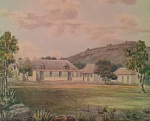 Henry Berkeley Jones (1846)
was a younger son of an ancient landed family in Anglesey, originally
Hampton, then (when the male line dropped out) Jones, then Hampton
Jones or Hampton Lewis. They owned Henllys, near Beaumaris [later a
Franciscan friary, now apartments next to a golf course]. Henry's
father Robert Edward Jones eschewed all this and, after Oxford, and
marriage to Susannah Dorothea Williams, was ordained and became a
missionary, first in South Africa and then from 1812 as civil and
military chaplain in Mauritius, on a stipend of £300. They lived at
Mangro [sic] Grove [right],
which had a small mango plantation attached. He spoke fluent French and
learnt Creole, but was passed over for promotion as senior
chaplain. Here Henry was born in 1813, and his sister Anna the following year.
Henry Berkeley Jones (1846)
was a younger son of an ancient landed family in Anglesey, originally
Hampton, then (when the male line dropped out) Jones, then Hampton
Jones or Hampton Lewis. They owned Henllys, near Beaumaris [later a
Franciscan friary, now apartments next to a golf course]. Henry's
father Robert Edward Jones eschewed all this and, after Oxford, and
marriage to Susannah Dorothea Williams, was ordained and became a
missionary, first in South Africa and then from 1812 as civil and
military chaplain in Mauritius, on a stipend of £300. They lived at
Mangro [sic] Grove [right],
which had a small mango plantation attached. He spoke fluent French and
learnt Creole, but was passed over for promotion as senior
chaplain. Here Henry was born in 1813, and his sister Anna the following year.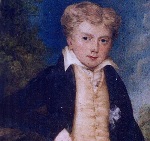 He was sent to England in
1826 (the painting right is
from that year - image from later life needed!) and attended
Charterhouse and St John's College Cambridge. He returned to Mauritius
in 1837, in which year his father died, and was appointed a special
magistrate, described as a young man of good education, the son of the Chaplain to the forces in this island. Back in England, and
ordained in 1839 he
served curacies in the then-extensive Chester diocese, though there is
some conflict in the records: he was certainly at Whalley [now
Blackburn diocese], appearing in the marriage registers; then from 1841
at St James Toxteth Park [now Liverpool], and at Wigan the following year [also now Liverpool]. In 1843,
he published a reply to the Rev James Henry Sutcliffe's pamphlet
accusing the Bishop of London of heresy and popery [on what grounds?]
of which the Christian Remembrancer wrote loftily
He was sent to England in
1826 (the painting right is
from that year - image from later life needed!) and attended
Charterhouse and St John's College Cambridge. He returned to Mauritius
in 1837, in which year his father died, and was appointed a special
magistrate, described as a young man of good education, the son of the Chaplain to the forces in this island. Back in England, and
ordained in 1839 he
served curacies in the then-extensive Chester diocese, though there is
some conflict in the records: he was certainly at Whalley [now
Blackburn diocese], appearing in the marriage registers; then from 1841
at St James Toxteth Park [now Liverpool], and at Wigan the following year [also now Liverpool]. In 1843,
he published a reply to the Rev James Henry Sutcliffe's pamphlet
accusing the Bishop of London of heresy and popery [on what grounds?]
of which the Christian Remembrancer wrote loftily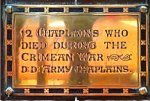 George Mockler
(1847-54), of Trinity College Dublin, fifth son of a
Lieutenant-Colonel, ordained by the Bishop of Worcester, who was the
first of twelve chaplains to die in
the Crimean War, to whom there is a memorial
at the Royal Garrison
Church, Portsmouth [right]. Appointed
to the troops at Malta in April 1854, he died six months later of
cholera, having been carried on a stretcher to Balaclava. Shortly
before he died, Henry Press Wright (later an archdeacon on Vancouver)
read the service for the Visitation of the Sick over him, and he
murmured beautiful prayers, beautiful prayers. A
tablet over the north-west door of Christ Church read
George Mockler
(1847-54), of Trinity College Dublin, fifth son of a
Lieutenant-Colonel, ordained by the Bishop of Worcester, who was the
first of twelve chaplains to die in
the Crimean War, to whom there is a memorial
at the Royal Garrison
Church, Portsmouth [right]. Appointed
to the troops at Malta in April 1854, he died six months later of
cholera, having been carried on a stretcher to Balaclava. Shortly
before he died, Henry Press Wright (later an archdeacon on Vancouver)
read the service for the Visitation of the Sick over him, and he
murmured beautiful prayers, beautiful prayers. A
tablet over the north-west door of Christ Church read| Erected to the memory of the Rev. George Mockler M.A., formerly Curate of this church and later Chaplain attached to Third Division of the British Army in alliance with France and Turkey engaged against Russia in actual warfare. He had endeared himself during a ministry of 7 years to his late Congregation who have raised this memorial of their attachment and esteem. The zeal evinced by him for the welfare of the dying, sick and wounded after the battle of the Alma so enervated his physical energies that he sank under the heavy labour imposed upon his exhausted nature. He died on the 2nd day of October 1854, in the 34th year of his age. His remains were interred upon the heights of Sebastopol. |
 Alfred
Conder
(1863-65) - MA and LLM of Queen's College Cambridge and ordained to this parish (he
published his farewell sermon The Future Meeting); his
father-in-law G. Hartwell Roe then appointed him rector of Middleton-on-Sea, a village of 71
souls near Bognor (on whose his death Conder himself became the patron) - church right. The parish had suffered greatly from the encroachments of the sea. Here,
until he died in 1895, at Middleton House (with eight children and six
servants), he ran a private school for boys (he was also described as
chaplain of the Merchant Taylors' Company convalescent home - was this
the same institution?), with British, Canadian and Chinese pupils. The
local history archive notes that he
could regularly be seen taking groups of boys to church by wagonette
and for a number of years these boys formed the major part of the
congregation. But services were often cancelled for want
of a attenders. He took a leading part in the affairs of the town, was
a member of the Royal Meteorological Society, and wrote on education
matters, including giving
approval to the New Gymnastics for Men, Women and Children developed
by the American Dio Lewis, and based on callisthenics, dumb-bells and
'pangymnastikon':
Alfred
Conder
(1863-65) - MA and LLM of Queen's College Cambridge and ordained to this parish (he
published his farewell sermon The Future Meeting); his
father-in-law G. Hartwell Roe then appointed him rector of Middleton-on-Sea, a village of 71
souls near Bognor (on whose his death Conder himself became the patron) - church right. The parish had suffered greatly from the encroachments of the sea. Here,
until he died in 1895, at Middleton House (with eight children and six
servants), he ran a private school for boys (he was also described as
chaplain of the Merchant Taylors' Company convalescent home - was this
the same institution?), with British, Canadian and Chinese pupils. The
local history archive notes that he
could regularly be seen taking groups of boys to church by wagonette
and for a number of years these boys formed the major part of the
congregation. But services were often cancelled for want
of a attenders. He took a leading part in the affairs of the town, was
a member of the Royal Meteorological Society, and wrote on education
matters, including giving
approval to the New Gymnastics for Men, Women and Children developed
by the American Dio Lewis, and based on callisthenics, dumb-bells and
'pangymnastikon':
| Violent gymnastics, like violent muscular exertion of every kind, are most injurious. As a Cambridge man, I have had many opportunities of observing this; and it is well known that those who in early manhood were distinguished for their skill in athletic sports, too frequently pay the penalty for their disregard of the laws of health, by premature loss of vigour. I am acquainted with a large public school in Ireland, in which violent games were at one time very much in vogue; but it was observed that diseases of the heart became prevalent among the boys; and the result was, that the authorities had to prohibit the objectionable sports..... This system, therefore, deserves the serious consideration of all teachers, as it appears to afford ample scope for the due exercise of the muscles, without the risk of producing any of the evils to which other plans often gave rise. |
 After
two
further London curacies (Holy Trinity Chelsea and St Simon Zelotes
Bethnal Green) Hill returned to his
native Wales, to three incumbencies in Llandaff and Monmouth dioceses.
He was the first incumbent of St Paul Grangetown, Canton (in Cardiff)
from 1894
- a church built a few years earlier. to serve a deprvied area of
16,000 people, by Lord Windsor at a cost of
£4,000 in Early English/Decorated style, seating 450 - [right: listed Grade II in 1975, it was used for filming an episode of Dr Who in 2005, and was then put up for sale, with an asking price of £300,000]. Hill had an endowment
of £60, a stipend of £180 and a parsonage at 64 Clive Street. In 1895 he reported on its Relief Committee to the Charity Organisation Society (having been actively involved with its work in London); he was also a committee member of the National Vigilance Association and International Bureau for the Suppression of Traffic in Women and Children
(in existence 1885-1953). In 1911 he moved to Llangwm, near Usk, and in 1922 to St
John Ebbw Vale from 1922. From 1921 he was a
regional organising secretary of the Society for the Propagation of the Gospel. He and his wife died in a motor accident in Weston-super-Mare in 1931.
After
two
further London curacies (Holy Trinity Chelsea and St Simon Zelotes
Bethnal Green) Hill returned to his
native Wales, to three incumbencies in Llandaff and Monmouth dioceses.
He was the first incumbent of St Paul Grangetown, Canton (in Cardiff)
from 1894
- a church built a few years earlier. to serve a deprvied area of
16,000 people, by Lord Windsor at a cost of
£4,000 in Early English/Decorated style, seating 450 - [right: listed Grade II in 1975, it was used for filming an episode of Dr Who in 2005, and was then put up for sale, with an asking price of £300,000]. Hill had an endowment
of £60, a stipend of £180 and a parsonage at 64 Clive Street. In 1895 he reported on its Relief Committee to the Charity Organisation Society (having been actively involved with its work in London); he was also a committee member of the National Vigilance Association and International Bureau for the Suppression of Traffic in Women and Children
(in existence 1885-1953). In 1911 he moved to Llangwm, near Usk, and in 1922 to St
John Ebbw Vale from 1922. From 1921 he was a
regional organising secretary of the Society for the Propagation of the Gospel. He and his wife died in a motor accident in Weston-super-Mare in 1931.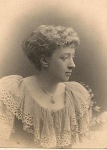 James
William Brodrick Sproule (1886-88), born
in Bath in 1852, where his Irish-born father (c1812-91) was incumbent of
St Mark Lyncombe, and an Oxford graduate, he was ordained in 1875 and
served two curacies in
Lichfield diocese (Quarry Bank and Dudley) and then in 1883 was briefly
the first curate of St Elisabeth Reddish,
a beautiful and defiantly anglo-catholic church by Alfred Waterhouse (part of
a suite of local buildings) in south Manchester. In June
1883, he officiated at St Jude Liverpool when the incumbent, Ernest
James Augustus FitzRoy, was inhibited by Bishop Ryle pending a
ritualism case in the Court of Arches, Taylor v. Fitzroy, following disturbances
similar to those at St George-in-the-East over a generation earlier
(FitzRoy was present, clutching the alms dish). This may have made him
unemployable for a time, but he then came to Christ
Church and to a further curacy at St Clement Barnsbury (marrying his wife Edith Ward Shaw in Wolverhampton in 1886),
returning in 1893 to three more in the north-west (Christ Church Ashton-under-Lyne, St James Latchford
and Birchfield), before coming back to London in 1900 as curate, for a number of years,
of St Luke Stepney; he died in Banbury in 1925. His glamorous sister May (or Mary) - right - married George Hess; they lived in Paddington, and Mentone, France.
James
William Brodrick Sproule (1886-88), born
in Bath in 1852, where his Irish-born father (c1812-91) was incumbent of
St Mark Lyncombe, and an Oxford graduate, he was ordained in 1875 and
served two curacies in
Lichfield diocese (Quarry Bank and Dudley) and then in 1883 was briefly
the first curate of St Elisabeth Reddish,
a beautiful and defiantly anglo-catholic church by Alfred Waterhouse (part of
a suite of local buildings) in south Manchester. In June
1883, he officiated at St Jude Liverpool when the incumbent, Ernest
James Augustus FitzRoy, was inhibited by Bishop Ryle pending a
ritualism case in the Court of Arches, Taylor v. Fitzroy, following disturbances
similar to those at St George-in-the-East over a generation earlier
(FitzRoy was present, clutching the alms dish). This may have made him
unemployable for a time, but he then came to Christ
Church and to a further curacy at St Clement Barnsbury (marrying his wife Edith Ward Shaw in Wolverhampton in 1886),
returning in 1893 to three more in the north-west (Christ Church Ashton-under-Lyne, St James Latchford
and Birchfield), before coming back to London in 1900 as curate, for a number of years,
of St Luke Stepney; he died in Banbury in 1925. His glamorous sister May (or Mary) - right - married George Hess; they lived in Paddington, and Mentone, France.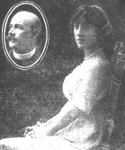 In 1903 he completed the re-decoration of St Paul's chancel with his own hands, saving the church an estimated £300: In a poor parish like mine the only way to get the people into church is by
appealing to the senses. Most city churches are dull and dingy inside
as well as out. Three years ago I made up my mind to try to improve the
church, and although it was hard work, and I had not very much time, I have now completely redecorated the chancel. He used £50 of gold leaf, stencilling a design on the walls and a Last Supper over the altar. In 1914 the Illustrated London News reported A
young man who appeared at the London Guildhall on a charge of
assaulting Miss Lewthwaite, an actress, was fortunate. Learning that he
bore a good character Miss Lewthwaite forgave him. Her father, the Rev.
J.H. Lewthwaite, a Clerkenwell vicar, pleaded for him, and he escaped
with a fine [right]. He ministered at St Paul Clerkenwell until his death in 1936 aged 80.
In 1903 he completed the re-decoration of St Paul's chancel with his own hands, saving the church an estimated £300: In a poor parish like mine the only way to get the people into church is by
appealing to the senses. Most city churches are dull and dingy inside
as well as out. Three years ago I made up my mind to try to improve the
church, and although it was hard work, and I had not very much time, I have now completely redecorated the chancel. He used £50 of gold leaf, stencilling a design on the walls and a Last Supper over the altar. In 1914 the Illustrated London News reported A
young man who appeared at the London Guildhall on a charge of
assaulting Miss Lewthwaite, an actress, was fortunate. Learning that he
bore a good character Miss Lewthwaite forgave him. Her father, the Rev.
J.H. Lewthwaite, a Clerkenwell vicar, pleaded for him, and he escaped
with a fine [right]. He ministered at St Paul Clerkenwell until his death in 1936 aged 80.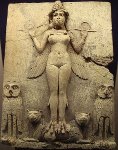 Right is the 'rod and ring' symbol from the Code of Hammurabi about which he wrote in 1905. Later he turned to more
racy articles about
sex (writing on original sin, and phallic symbolism, in The American
Journal of Urology and Sexology), birth
control,
and other subjects such as 'Does Nakedness tend to promote
Immorality?', 'Women and Clothes' and so on, until his death in 1922. He came to the defence of William Montgomery Brown,
Bishop of Arkansas, who was tried and deposed for heresy - he was both
a self-professed Communist and denied the literal and supernatural
interpretation of scripture - in a work (published posthumously in
1925) Why the Protestant Episcopal Church in the United States of America has no power to try Bishop William Montgomery Brown. In 1899 he published a review (in Bibliotheca Sacra) of William Walsh's scurrilous Secret History of the Oxford Movement; and in 1910 he collaborated with Brown on The Level Plan for Church Union.
Right is the 'rod and ring' symbol from the Code of Hammurabi about which he wrote in 1905. Later he turned to more
racy articles about
sex (writing on original sin, and phallic symbolism, in The American
Journal of Urology and Sexology), birth
control,
and other subjects such as 'Does Nakedness tend to promote
Immorality?', 'Women and Clothes' and so on, until his death in 1922. He came to the defence of William Montgomery Brown,
Bishop of Arkansas, who was tried and deposed for heresy - he was both
a self-professed Communist and denied the literal and supernatural
interpretation of scripture - in a work (published posthumously in
1925) Why the Protestant Episcopal Church in the United States of America has no power to try Bishop William Montgomery Brown. In 1899 he published a review (in Bibliotheca Sacra) of William Walsh's scurrilous Secret History of the Oxford Movement; and in 1910 he collaborated with Brown on The Level Plan for Church Union. John
Henry Bovill
(1888-90)
was born in Whitby in 1862. His Cambridge studies were based at Ayerst
Hall, a short-lived
private hostel in Queen Anne's Terrace, for less-wealthy students founded by the Revd William Ayerst (whose father had been associated with this parish for a time in the 1840s).
Ordained deacon to St Clement Toxteth Park in Liverpool in 1885, he
came to St Mary Poplar the following year and then to Christ Church
(and was priested in 1889). After a further curacy in Long Stowe,
Cambridgeshire he went in 1894 as missionary in Lebombo, joining its
first bishop William Edmund Smyth; he was Rector of the Cathedral
at Lourenço Marques
[now Maputo], and Her Majesty's
Acting Consul. He wrote Natives under the Transvaal Flag
(Simkin Marshall 1900) detailing the iniquities of the racist
constitution which confined native mineworkers to 'compounds' subject
to pass laws, and denied legal access. It is quoted at some length in Josephine Butler's short book Native Races and the War (Gay & Bird 1900). See further H.P. Thompson Into All Lands: The History of the Society for the Propagation of the Gospel in Foreign Parts 1701-1950. Another short book, Delagoa [now Maputo] Bay: Its Past, Present and Prospective Future followed. He
returned in 1901 and officiated in London, St Albans, Kingsthorpe in
Northamptonshire and at St Andrew Romford until 1920, living latterly
in Ilford, and died in 1933.
John
Henry Bovill
(1888-90)
was born in Whitby in 1862. His Cambridge studies were based at Ayerst
Hall, a short-lived
private hostel in Queen Anne's Terrace, for less-wealthy students founded by the Revd William Ayerst (whose father had been associated with this parish for a time in the 1840s).
Ordained deacon to St Clement Toxteth Park in Liverpool in 1885, he
came to St Mary Poplar the following year and then to Christ Church
(and was priested in 1889). After a further curacy in Long Stowe,
Cambridgeshire he went in 1894 as missionary in Lebombo, joining its
first bishop William Edmund Smyth; he was Rector of the Cathedral
at Lourenço Marques
[now Maputo], and Her Majesty's
Acting Consul. He wrote Natives under the Transvaal Flag
(Simkin Marshall 1900) detailing the iniquities of the racist
constitution which confined native mineworkers to 'compounds' subject
to pass laws, and denied legal access. It is quoted at some length in Josephine Butler's short book Native Races and the War (Gay & Bird 1900). See further H.P. Thompson Into All Lands: The History of the Society for the Propagation of the Gospel in Foreign Parts 1701-1950. Another short book, Delagoa [now Maputo] Bay: Its Past, Present and Prospective Future followed. He
returned in 1901 and officiated in London, St Albans, Kingsthorpe in
Northamptonshire and at St Andrew Romford until 1920, living latterly
in Ilford, and died in 1933. Edward Frith
Everett
(1890-92) - right -
born in Stamford in 1866 (his family had been millers in Norfolk, but
his father Edward Hawley Everett had been a curate in Parr, St Helen's,
and then chaplain of the workhouse in Stamford, and later incumbent of
Wittering in Norfolk),
he began his ministry here after Pembroke
College Cambridge; after two other London curacies and a third at St
Lawrence Northampton, from 1906, and 15 years at Little Bowden (Market
Harborough)
- the final one as Vicar - he returned to St Lawrence Northampton as
incumbent in 1921. In 1928 he published a history of the first fifty
years of that parish. He died in 1933 (and is remembered on 9 August by the Guild of All Souls): the Hull Daily Mail of 10 August reported
Edward Frith
Everett
(1890-92) - right -
born in Stamford in 1866 (his family had been millers in Norfolk, but
his father Edward Hawley Everett had been a curate in Parr, St Helen's,
and then chaplain of the workhouse in Stamford, and later incumbent of
Wittering in Norfolk),
he began his ministry here after Pembroke
College Cambridge; after two other London curacies and a third at St
Lawrence Northampton, from 1906, and 15 years at Little Bowden (Market
Harborough)
- the final one as Vicar - he returned to St Lawrence Northampton as
incumbent in 1921. In 1928 he published a history of the first fifty
years of that parish. He died in 1933 (and is remembered on 9 August by the Guild of All Souls): the Hull Daily Mail of 10 August reported| Whilst preaching last night to a large congregation at St Lawrence's Church, Northampton, the vicar ... suddenly collapsed in the pulpit. Members of the congregation rushed to his aid, and he was carried into another part of the church where, despite efforts at artificial respiration, he died within a few minutes The remainder of the service was abandoned and the congregation dispersed unaware of their vicar's death. Mr Everett who was 66 years of age had been treated for heart trouble for six years and as his doctor was able to give a certificate as to the cause of death the Borough Coroner has decided not to hold an inquest. A few hours before his death Mr Everett officiated at the funeral service of one of his wardens, and this and the intense heat is believed to have affected him. |
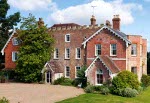 Hugh Randolph
Cavendish Smith-Marriott (1897-99),
of Magdalen
College, Cambridge. In 1825 the Rev William Marriott Smith-Marriott
inherited a baronetcy and a 116-acre estate at Horsmonden in Kent, with
a house (now Grade II*) incorporating 15th and 16th century features
and a grand Georgian wing to which many Victorian additions inside and
outside were made. Hugh served curacies in Swindon and Dover before
coming here, and returned to Horsmonden (in Rochester diocese) as
curate from 1905, and Vicar from 1922, until his death in 1944 (having
briefly become the 9th Baronet Smith-Marriott of Sydling St Nicholas),
when the estate was sold.
Hugh Randolph
Cavendish Smith-Marriott (1897-99),
of Magdalen
College, Cambridge. In 1825 the Rev William Marriott Smith-Marriott
inherited a baronetcy and a 116-acre estate at Horsmonden in Kent, with
a house (now Grade II*) incorporating 15th and 16th century features
and a grand Georgian wing to which many Victorian additions inside and
outside were made. Hugh served curacies in Swindon and Dover before
coming here, and returned to Horsmonden (in Rochester diocese) as
curate from 1905, and Vicar from 1922, until his death in 1944 (having
briefly become the 9th Baronet Smith-Marriott of Sydling St Nicholas),
when the estate was sold.| MAY NOT RETURN Canon A.R. Barlee, who has not visited his home in England since 1947, left on Thursday by the Golfito for the U.K., but it is uncertain whether he will be returning to the West Indies. Canon Barlee has four brothers and three sisters in Bedford who want him to return to England. He is the only surviving clergyman of a family which has for the past century and a half, maintained the tradition of always having a clergyman as a member of its household. |
 Charles
Harcourt
Blofeld (1905-06), born in 1881, served three separate stints as chaplain of
the training ship Mercury
before succeeding Fr Arthur Tooth (who in 1877 had been imprisoned for ritualism offences - more details here and here), as Warden of the preparatory school Tooth had founded, St Michael's,
Otford in Kent, from 1931 to his death in 1938 [chapel right]; he had earlier published A Book of Prayers for Boys, together with Special Prayers for the Holy Eucharist, &c. (Mowbrays 1908).
His younger brother Thomas Guest Blofeld
(b.1864) succeeded him in this post during and after the War, and died
in 1964. (A century before, a namesake ancestor trading in Middle-row,
Holborn and Clapham as a perfumer, dealer and chapman, was released from bankruptcy in 1827, having followed the directions of the court.)
Charles
Harcourt
Blofeld (1905-06), born in 1881, served three separate stints as chaplain of
the training ship Mercury
before succeeding Fr Arthur Tooth (who in 1877 had been imprisoned for ritualism offences - more details here and here), as Warden of the preparatory school Tooth had founded, St Michael's,
Otford in Kent, from 1931 to his death in 1938 [chapel right]; he had earlier published A Book of Prayers for Boys, together with Special Prayers for the Holy Eucharist, &c. (Mowbrays 1908).
His younger brother Thomas Guest Blofeld
(b.1864) succeeded him in this post during and after the War, and died
in 1964. (A century before, a namesake ancestor trading in Middle-row,
Holborn and Clapham as a perfumer, dealer and chapman, was released from bankruptcy in 1827, having followed the directions of the court.) 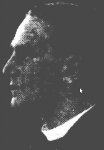 John Phillips Milne (1907-08)
was an Australian, born in Adelaide in 1877 and trained at St Barnabas
College there, serving curacies at Christ Church Mount Gambier, St
Bede's Semaphore in that diocese and then, in 1903, at St Andrew Middle
Brighton in Melbourne; he was also for a time tutor to the sons of Lord
Tennyson, Governor of South Australia. He visited England briefly, where he did much slum work with distinct success, as his obituary in the Adelaide Register (3 September 1924) put it. Similarly, at St James Sydney he did duty among the lower classes of the community in that State. His
ambition was to study at Cambridge, and he graduated from St John's
College - spending some time at the college's Lady Margaret Mission in
Walworth (begun in 1883, the first London mission of a Camridge
college), and as The Eagle of 1908 reported, speaking at college meetings about the mission as one outside the parish, and able to compare it with the part of London in which he is now working (namely, this parish). He did not return to Australia, and died (after an operation) in 1924, leaving an estate of £1600.
John Phillips Milne (1907-08)
was an Australian, born in Adelaide in 1877 and trained at St Barnabas
College there, serving curacies at Christ Church Mount Gambier, St
Bede's Semaphore in that diocese and then, in 1903, at St Andrew Middle
Brighton in Melbourne; he was also for a time tutor to the sons of Lord
Tennyson, Governor of South Australia. He visited England briefly, where he did much slum work with distinct success, as his obituary in the Adelaide Register (3 September 1924) put it. Similarly, at St James Sydney he did duty among the lower classes of the community in that State. His
ambition was to study at Cambridge, and he graduated from St John's
College - spending some time at the college's Lady Margaret Mission in
Walworth (begun in 1883, the first London mission of a Camridge
college), and as The Eagle of 1908 reported, speaking at college meetings about the mission as one outside the parish, and able to compare it with the part of London in which he is now working (namely, this parish). He did not return to Australia, and died (after an operation) in 1924, leaving an estate of £1600.
 Edwin
Castledine (1911-12) - pictured
-
born 1885, he too trained at King's (AKC) and was ordained in 1908, serving
curacies at Haverstock Hill and Dulwich before coming here; after a
further curacy in Southend (during which his American fiancée cancelled their wedding plans because of the war - see story right from the Berkeley Daily Gazette), he moved to Sheffield diocese as Vicar of
St Margaret Brightside from 1917-20, before spending four years in
California, where he gained a BD at the Pacific School of Religion at Berkeley
(publishing a monograph Jesus or Paul?
in 1925). He returned to Sheffield as Vicar of Balby from 1926-31 (in
which year the parish boundaries were altered), returned to California
for a time (serving at St Peter Redwood City, The Good Shepherd Belmont
and elsehwere), and back again to Sheffield from 1935-37 as curate-in-charge of the mission
church
of St Cuthbert Herringthorpe, built the previous year, and then Vicar
of the ancient parish of Thorne. He then returned to California,
serving in various parishes including Our Saviour, Placerville and St
Luke Auburn, and died in
1969.
Edwin
Castledine (1911-12) - pictured
-
born 1885, he too trained at King's (AKC) and was ordained in 1908, serving
curacies at Haverstock Hill and Dulwich before coming here; after a
further curacy in Southend (during which his American fiancée cancelled their wedding plans because of the war - see story right from the Berkeley Daily Gazette), he moved to Sheffield diocese as Vicar of
St Margaret Brightside from 1917-20, before spending four years in
California, where he gained a BD at the Pacific School of Religion at Berkeley
(publishing a monograph Jesus or Paul?
in 1925). He returned to Sheffield as Vicar of Balby from 1926-31 (in
which year the parish boundaries were altered), returned to California
for a time (serving at St Peter Redwood City, The Good Shepherd Belmont
and elsehwere), and back again to Sheffield from 1935-37 as curate-in-charge of the mission
church
of St Cuthbert Herringthorpe, built the previous year, and then Vicar
of the ancient parish of Thorne. He then returned to California,
serving in various parishes including Our Saviour, Placerville and St
Luke Auburn, and died in
1969.| On Sunday René de Naurois, his decorations a splash of colour on a white surplice, said Mass for three hundred men kneeling on the grass. At the Interdenominational Church Parade a favourite hymn, that has since become our own, was sung with feeling: Eternal Father, strong to save, O hear us when we cry to thee, For those in peril on the sea. It goes well with male voices, but the new padre preached a rotten sermon about death and destruction which caused surprise. There are few atheists to be found before a battle, or later in shell-holes. Tension was building up, and charity perhaps a trifle thin on the ground. There were a number of complaints; the cleric was suspended and told to return from whence he came. Poor fellow! A spark can cause the prairie fire! It was mistaken zeal from a man, lacking combat experience, who did not know his congregation, and doubly unfortunate in that it conflicted with my own 'God speed' before departure. The incident was forgotten but the dismissal was taken badly. On the last day in camp the unfortunate man took his own life. A sad business, with barely time for regrets, for troops were belting up amid the dust and shouting as embarkation transport came grinding in to Southampton to take us away. Max, a most humane officer and the soundest of administrators, cleared up the pitiful remains. The padre was put down as a "battle casualty". |
Homepage | About Us | Services & Events
| Church &
Churchyard |
History
Newsletters & Sermons | Contacts,
Links & Registers | Giving
| Picture
Gallery |
Site Map